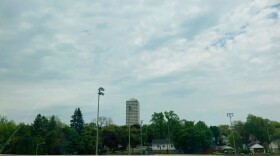In the midst of such a harsh winter, cabin fever is affecting young and old alike, as Lake Effect essayist George Berdes can attest:There isn’t a vaccine for it. Even if there were it would probably be in short supply…restricted to young children and the elderly. No, it’s not the flu. It’s that other seasonal malady fast approaching. Experts describe the problem as having a regional/climatic dimension. Sufferers are predominately located in rural snow-bound areas of the upper Midwest.
The first symptoms of retching blah’s are usually reported in mid-January. February can bring on epidemic levels of grunts, moans, and foam-mouthed growls toward loved ones. The severity of all this is usually in direct ratio to snow depth. Its intensity is heightened even more by persistent gray skies.
A haughty, taunting postcard from friends in Florida or Arizona can cause devastating spasms. Such pictorial reminders of other warm, sunny places can crank up violent storms of angst, junk-funk, and dreary melancholy.
Such is the heavy burden and toll of cabin fever.
For some the best elixir are picture puzzles in front of the fireplace every evening. For others, the attempted treatment is alcohol. That only produces other, even more serious problems.
There is also this absolute given about cabin fever: one infection does not provide guaranteed immunity against subsequent annual sieges. It can also be contagious.
What about avoidance strategies? The best and most promising is to stay productively busy. Being your own best friend in an isolated cabin in the woods can do wonders. Getting out, despite the challenge of icy roads and 20 below zero temperatures, is also highly recommended. Genuinely embracing active winter sports like cross-country skiing and snowshoeing is almost a sure prevention.
Cures for the afflicted are a little more elusive. Summer tans and spirits fade quickly in what Shakespeare called the long night that never finds the day. But turning on every light in the house can also turn on a malingering spirit. Even when the electric bill arrives it’s important to remember that it’s cheaper than the doctor’s bill. The dazzling effect of a full moon’s magic on a silent, snow-covered forest offers the sun worthy competition.
In my experience the ultimate answer to cabin fever is good old-fashioned pride – determined hardiness and clenched-teeth grit. Among my friends and neighbors up here in the white woods of Wisconsin there is a genuine awe at the breathtaking beauty of this place in winter. The soft stillness is a gift unsurpassed. Add to that the pride of self-sufficiency – the survivor’s achievement of having done it – and you come out a winner. Olympic gold medal winners know the feeling.
Sure, there’ll be some mud in March. But come April, the lakes begin to open up and the eagles are back and then the loons. It’s along about then that the snowbirds start returning. You know that feathered species – they have sand between their toes and flaunted suntans.
Hearty survivors welcome them back with open arms, of course. They swing open their cabin door to them. But there’s one thing they definitely do not do. Good taste and dignity preclude that. They never tell the snowbirds all the good things they missed during their absence. That would be too cruel.
Lake Effect essayist George Berdes lives part of the year in the north woods, and now deals with wintertime cabin fever in Milwaukee. Many of his essays first appeared on WXPR and on his blog, East of Eagle River – he’s sharing them now with us, as well.





